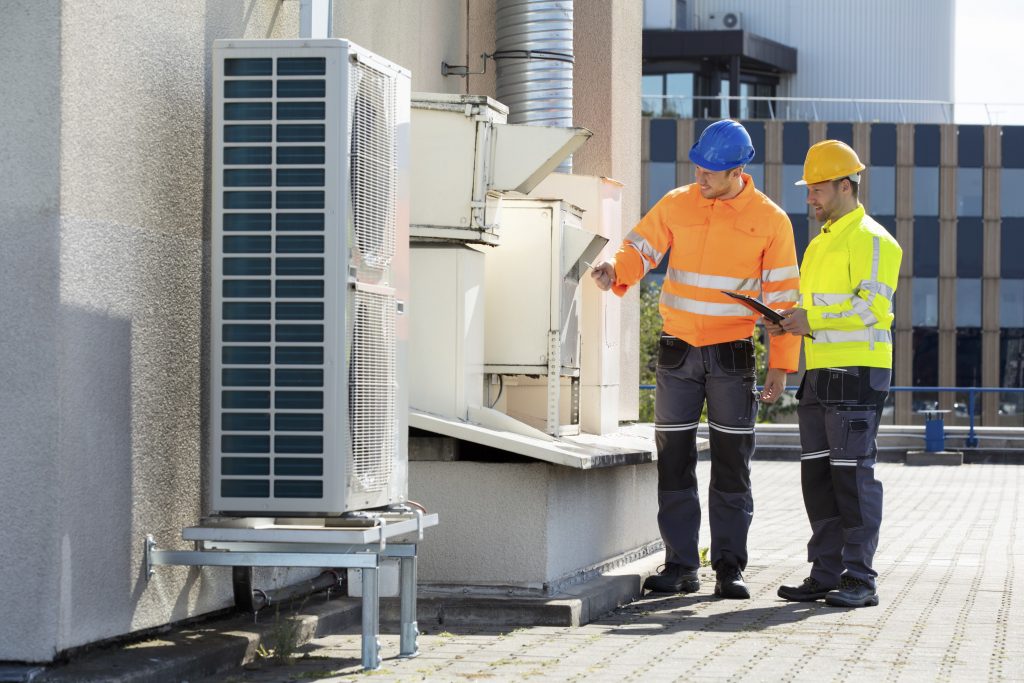Main Differences Between Commercial And Residential PTAC Units
Residential PTAC units are used in residential settings, while commercial PTAC units are used in commercial settings. Comparison in terms of main differences completed, right? Well, not exactly.

Air conditioner compressor outdoor unit installed outside the house
There would be notable differences between the systems even if you took two air conditioners that are identical, installed one in a home and one in a business. This post delves deeper into the main differences between commercial and residential PTAC units. Read on to learn more.
- Size
Commercial and residential PTAC units are very different in sizing generally. The ones for commercial application sometimes take up an entire roof, so they can be extremely large in scope. On the other hand, residential PTACs are highly uniform.
- System Complexity
Unlike commercial PTAC units, the residential ones have a less demanding job. That’s because they’re only required to maintain less diverse, smaller indoor environments.
Aside from accommodating more occupants, industrial PTACs must also adapt to the building’s needs, depending on the industry being carried out inside. PTAC units that keep commercial buildings properly ventilated are frequently in constant use. That being said, PTACs for commercial application must be resilient and contribute to the required engineering’s complexity since they’re carrying a heavy workload.
If you’re remotely selling PTAC units, you must be able to make the prospective buyer understand this important difference between commercial and residential PTACs. If you’re not sure how to do it effectively, remote selling programs, like the ones offered by Winning By Design
, can help.
- Design
Setups for PTAC units that are installed in houses tend to be domestic stand-alone in nature, compared to modular systems in commercial buildings.
Entry-level PTAC units are designed to produce only heating or cooling. That means they consist of a single-stage system. Of course, compared to other options, they tend to be cheaper, but they’re also working at full capacity even when it’s not required, so they’re relatively inefficient. That’s why you can commonly find the entry-level systems in homes. They’re also common in rental properties where paying the power bill isn’t the responsibility of the owner.
On the other hand, for the purpose of cutting down on power usage, more advanced PTAC models can offer variable fan speeds. You can find these in all settings. Compared to multi-stage systems, however, they’re still relatively inefficient. Therefore, when running in the long term, they’re more expensive.
Finally, multi-stage systems only work in their full capacity when needed. That’s because they’re designed to ramp up at the required capacity. You can commonly find PTAC units with multi-stage systems in commercial settings because they’re the most efficient option available.
- Drainage
Several pipes are necessary in facilitating drainage in a commercial PTAC unit. To prevent liquid overflow, there should also be enough catcher pans. That’s because PTACs for commercial application must process airflow for business buildings. On the other hand, even with just a pan and a single drainage pipe, a residential PTAC unit can effectively function.
- Customization
Commercial PTAC units allow greater customization by necessity. That’s why modular components are present in their systems, which can be removed or added where desired by an HVAC company.
BMS or building management systems are commonly tailored to the required building PTAC setup in addition to many commercial systems’ modular nature.
- Power Consumption
Of course, because they’re expected to handle higher workloads, PTAC units for commercial application typically draw more power.
In buildings and office spaces, around 30% of energy use is accounted for by air conditioning systems. Commercial ACs also dominate peak electricity demand of the building in terms of impact on total energy use and costs of a facility.
The energy usage figure in homes, interestingly enough, is higher as ACs account for around 40% of energy use in the majority of residences. That only means one thing: while a residential PTAC unit may use less power than a commercial system, the proportion of used power compared to usage is higher overall in the residential property. A ductless mini-split AC system, on the other hand, may be a more practical choice for some people because they are more energy-efficient than PTAC systems. Those who want to install ductless AC in their homes should contact an HVAC company, like Magnolia Heating and Cooling.
- Filters
By protecting the system from dust and airborne particles, a filter helps in increasing the AC’s efficiency and longevity.
Compared to residential PTAC units, a wide range of AC filters are utilized in commercial application. Manufacturer-specific split system filters and ducted panel filters are commonplace in homes. In commercial settings, on the other hand, you’ll find HEPA, carbon, v-bank, pocket/bag, and pleated filters.
Final Thoughts
PTAC units, like any other HVAC system, works to heat, cool, and ventilate a building. However, a commercial building’s air conditioning requirements aren’t the same as those of residential spaces. Two separate PTAC systems have been developed as a result in order to fulfill different needs. Hopefully, the differences between commercial and residential PTAC units discussed above can help you decide which system is really best for your needs.

